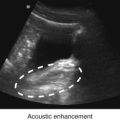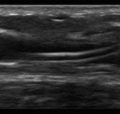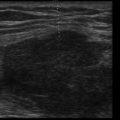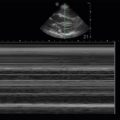Key Points
- •
Ultrasound waves are scattered at an air interface. Normal or partially aerated lungs produce reverberation artifacts in discrete patterns that correlate with underlying pathology.
- •
Thoracic ultrasonography is superior to traditional physical exam or chest radiography to evaluate causes of acute dyspnea and has nearly equivalent accuracy with CT scans.
- •
Literature supporting use of bedside lung ultrasonography continues to grow, but training and credentialing of providers have lagged behind.
Background
While early descriptions in localizing pleural effusions with ultrasound date back to the 1960s, historically, radiologists have not applied ultrasound to the lung due to a misperception that lung ultrasound was of limited utility given the highly reflective properties of air. In the 1980s, descriptions of equine lung ultrasonography emerged in the literature. Later, innovative and groundbreaking research by Lichtenstein and others demonstrated that ultrasound artifacts created by the pleural line could be correlated with underlying parenchymal and pleural pathology in critically ill patients. These findings included description of lung sliding correlating with an intact parietal and visceral pleural interface and B-lines being present in pathologic states. Building upon these findings, Lichtenstein recognized that consolidated (i.e., airless) lung parenchyma was easily visualized, increasing potential applications of lung ultrasound examination. Understanding of these easily recognizable artifacts combined with technological advancement of portable ultrasound machines have made lung ultrasonography a common and indispensable application of point-of-care ultrasound.
Indications and Applications
Currently, lung ultrasound (LUS) is practiced in a variety of clinical settings. In emergency departments and inpatient rapid response situations, LUS can facilitate the differential diagnosis of acute respiratory failure by identifying pneumonia, acute pulmonary edema, pulmonary embolism (when used in conjunction with other point-of-care ultrasound techniques), pneumothorax, or strongly suggesting obstructive lung disease using the BLUE Protocol described by Lichtenstein. Trauma services use ultrasound to rapidly diagnose pneumothorax, hemothorax, and lung contusions at the bedside with equal or greater diagnostic accuracy compared to physical exam and chest radiography combined. LUS can also identify safe locations for tube thoracostomy when indicated.
LUS practiced by experienced intensivists has been shown to be a more accurate diagnostic tool than traditional chest radiography for interstitial syndrome (sensitivity 94% vs. 46%), consolidation (sensitivity 100% vs. 38%), pleural effusion (100% vs. 65%), and pneumothorax (88% vs. 52%). Additionally, pleural effusions can be characterized in the intensive care unit (ICU) by evaluating the echogenic quality of the fluid. Such characterizations include the hematocrit sign and plankton sign. Pleural fluid volume assessment, thoracentesis guidance, and postprocedure evaluation are all applications of LUS supported in multiple studies with added benefits of decreasing complications, radiation exposure, and cost. As the use of pulmonary artery catheters has been shown to be of limited benefit in acute respiratory distress syndrome (ARDS), various papers have looked at differentiating ARDS from acute pulmonary edema by LUS. One study demonstrated that finding areas of interstitial sparing and thickened irregular pleura differentiated ARDS from acute pulmonary edema nearly perfectly. LUS has also been used to guide lung recruitment during mechanical ventilation. Quantification of extravascular lung water in animal models and patients with congestive heart failure, estimation of pulmonary capillary wedge pressure, as well as response to diuresis and hemodialysis can be assessed by LUS. LUS can immediately rule out a postprocedure pneumothorax following placement of a central venous catheter with real-time ultrasound guidance.
The utilization of LUS extends beyond acute care settings. Lung ultrasonography has been utilized to screen for early interstitial lung disease in patients with systemic sclerosis, potentially limiting radiation exposure. Peripheral lung nodules and pleural masses can be biopsied under ultrasound guidance. Similar to the ICU, LUS conducted in clinics or outpatient procedure centers can guide pleural drainage or placement of an indwelling drain in patients with malignant pleural effusions. Postbronchoscopic LUS assessment can evaluate for pneumothorax, eliminating the cost, delay, and radiation exposure of chest radiography, which has lower sensitivity compared to LUS.
The decreasing size of portable ultrasound machines and evolving software packages have made operation of these machines easier, giving rise to a growing body of literature demonstrating higher or equivalent sensitivity and specificity of LUS compared to other imaging modalities. By combining clinical and radiographic findings at the bedside, point-of-care LUS is a powerful diagnostic tool that empowers clinicians to guide management decisions and improve patient care.
Stay updated, free articles. Join our Telegram channel

Full access? Get Clinical Tree






